Key takeaways:
- Understanding audience engagement goals is essential for crafting impactful presentations that foster genuine interaction.
- Researching audience needs through demographic analysis and feedback ensures content resonates and engages effectively.
- Utilizing diverse engagement formats, like workshops or fireside chats, enhances participation and connection with the audience.
- Continuously evaluating engagement outcomes and adjusting strategies promotes ongoing improvement and relevance in speaker engagements.
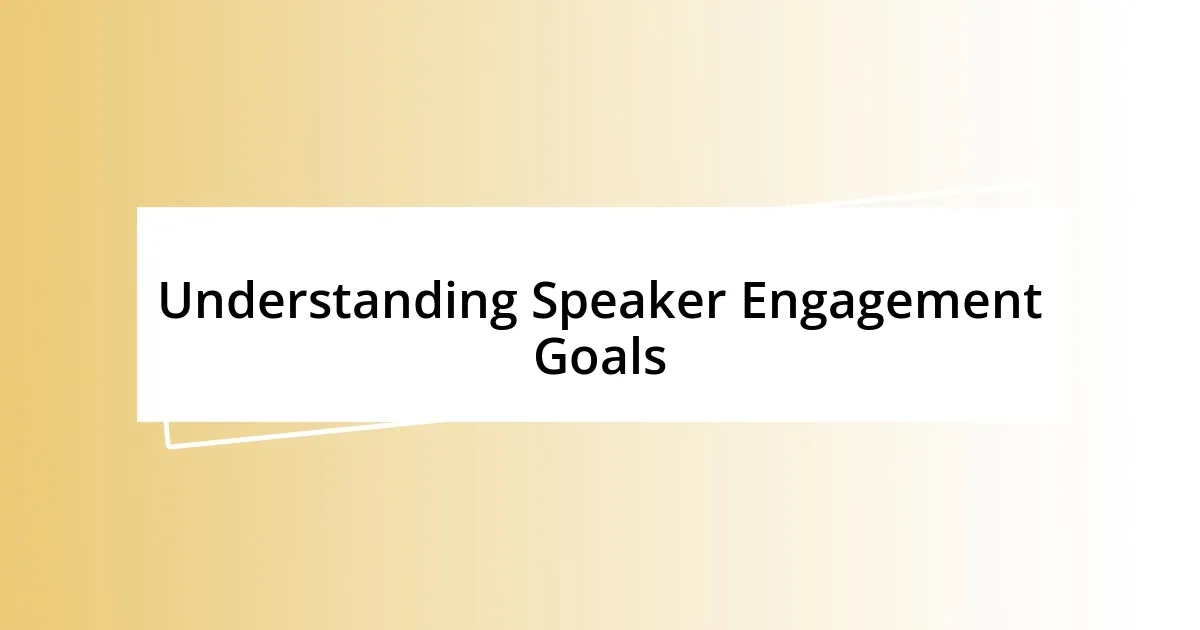
Understanding Speaker Engagement Goals
Understanding speaker engagement goals is vital for creating impactful events. I remember my first speaking engagement; I was so focused on delivering my content that I barely connected with the audience. Reflecting on that experience, I realized that the primary goal should always be to foster genuine interaction and understanding. What do you want your audience to feel?
I’ve found that setting clear engagement goals helps in shaping the message and crafting the delivery. For instance, if the aim is to inspire action, the call to action must resonate deeply with the listeners’ emotions. As I think back to my most successful talks, they weren’t just about sharing information—they were about stirring something within the audience, encouraging them to reflect on their own experiences.
Moreover, it’s essential to consider how different goals can require different approaches. Sometimes, I’ve aimed for knowledge transfer, emphasizing facts and figures. Other times, my focus shifted toward motivation, where storytelling played a key role. Have you thought about which approach feels right for your next engagement? Understanding these nuances in your goals can truly transform the effectiveness of your presentation.
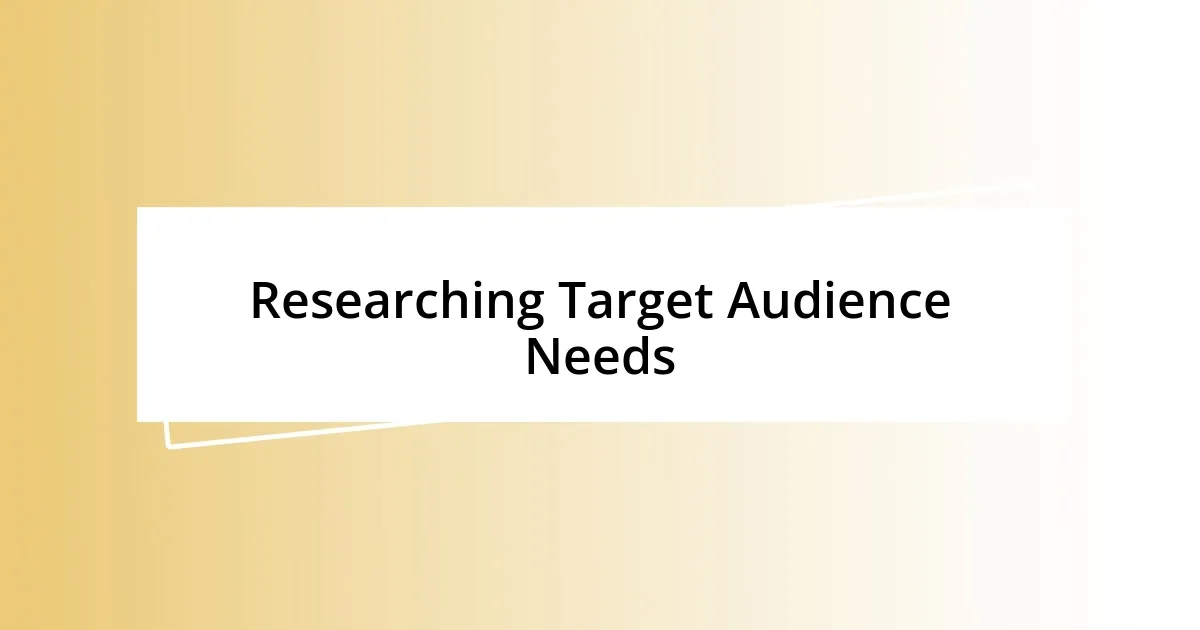
Researching Target Audience Needs
Researching the target audience needs is a fundamental step that shapes how I deliver my message. There have been times when I assumed I knew what the audience wanted, only to realize too late that my content didn’t resonate. It’s crucial to dive into their interests and pain points through various channels. This can mean reading up on industry trends, surveying potential attendees, or even engaging with them on social media. The more I understand, the better equipped I am to tailor my presentation.
- Identify demographic details, such as age, profession, and interests.
- Analyze feedback and comments from previous events.
- Conduct surveys or polls to gather direct input.
- Explore online forums or groups where your audience engages.
- Monitor social media discussions to spot trending topics.
- Use analytics from any past presentations to gauge what resonated most.
For me, this investigative process turns into a personal journey. I remember crafting a presentation for a group of young entrepreneurs; after some diligent research, I discovered they craved practical tips over theory. Tailoring my approach based on their specific needs made all the difference. It felt rewarding to engage them authentically, and I could see their excitement grow as they recognized that the content was speaking directly to them. This reinforces my belief that understanding needs is not just a checkbox but a powerful way to connect meaningfully with an audience.
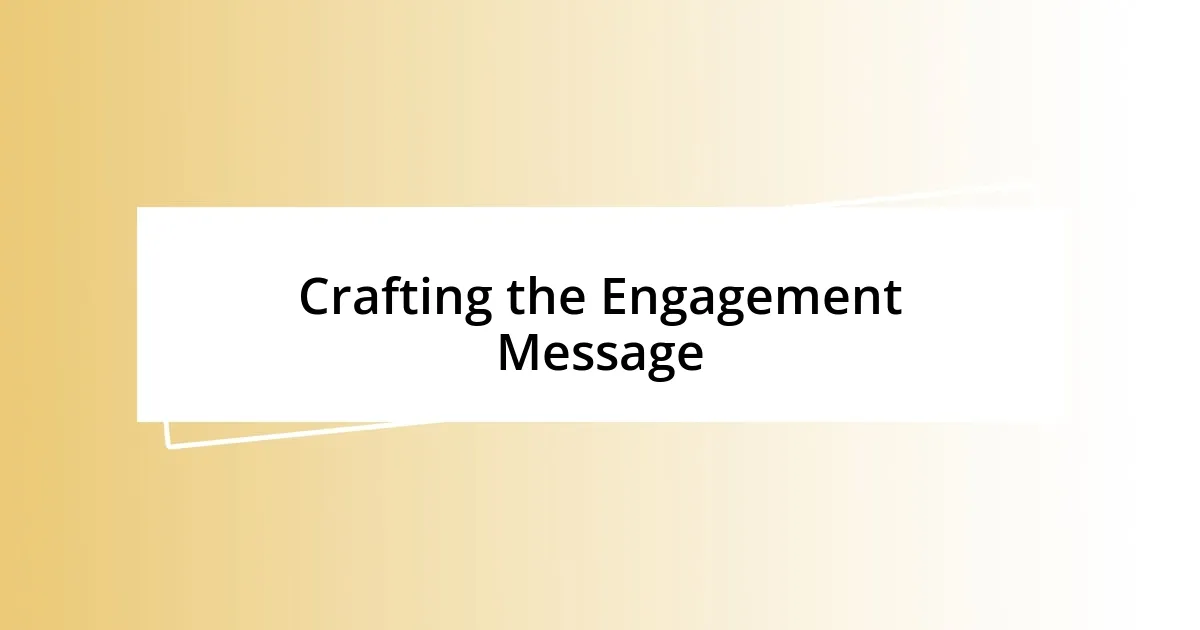
Crafting the Engagement Message
Crafting the engagement message is like painting a canvas; it requires layers of thought and intention. I remember a time when I was preparing a keynote speech, and I struggled with how to frame my message. After much reflection, I realized the importance of intertwining storytelling with my data. This approach not only conveyed information but also evoked emotions. Stories create connections and can turn a dry statistic into a personal journey, making the message resonate deeply with the audience.
The emotions I aimed to evoke were pivotal in shaping my message. For instance, during a session on resilience, I shared my experience of overcoming a significant challenge. This not only made the content more relatable but also created a space where others felt comfortable sharing their experiences. Isn’t it fascinating how vulnerability can transform an engagement? This kind of authenticity encourages audience participation and fosters a sense of community.
Ultimately, clarity is crucial when crafting the engagement message. I’ve found that structuring my points with simplicity helps in avoiding any confusion. A clear message makes it easier for the audience to grasp the key takeaways. This is why I often create outlines or mind maps before finalizing my presentation. Have you considered how your message is structured? A thoughtful arrangement can enhance the overall impact and ensures that the audience leaves with the intended insights.
| Key Element | Description |
|---|---|
| Storytelling | Connects emotionally and makes complex ideas relatable. |
| Authenticity | Sharing personal experiences fosters trust and encourages audience engagement. |
| Clarity | Clear structure aids comprehension and retention of key messages. |
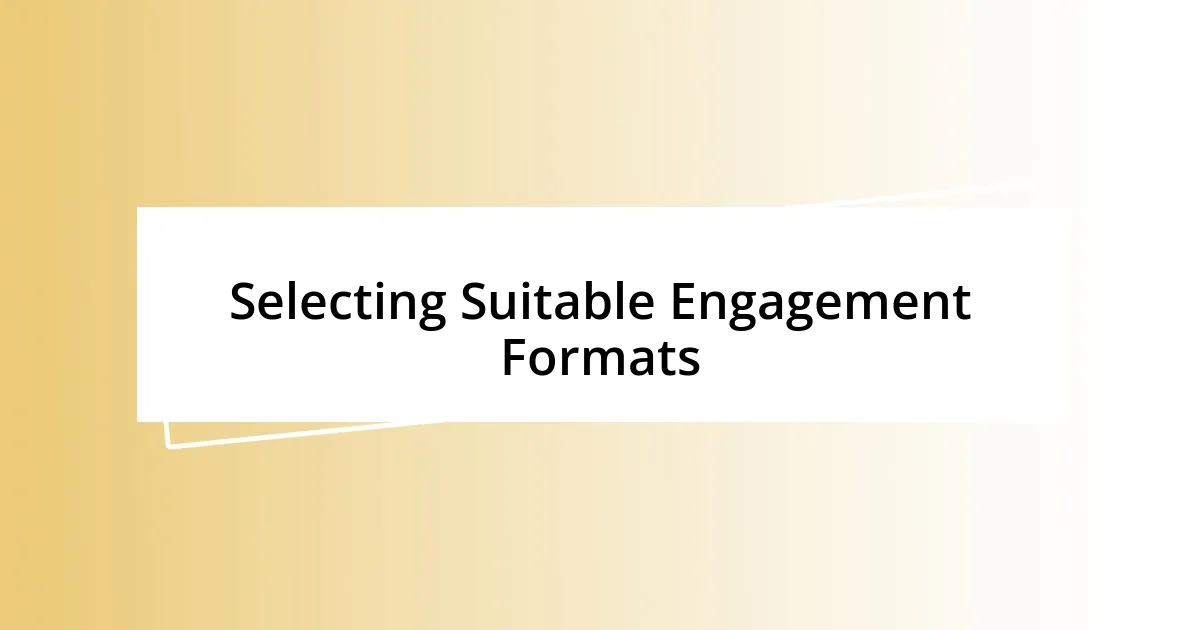
Selecting Suitable Engagement Formats
Selecting the right engagement format is key to connecting with the audience effectively. I recall a conference where I had the choice between a workshop and a panel discussion. Initially, I leaned towards the panel, thinking the multiple perspectives would be engaging, but then I remembered how hands-on workshops allowed for richer interactions. I opted for the workshop format, which resulted in a much more dynamic environment where attendees were eager to share and collaborate. Reflecting on that, I now carefully consider which format will invite the most participation and create the perfect atmosphere for dialogue.
As I explore various formats, I often ask myself: what do I want the audience to walk away with? For instance, during a recent presentation, I tried a new format—a fireside chat. This intimate setting allowed me to share my insights while directly addressing audience questions in real-time. The energy in the room shifted; it felt less like a presentation and more like a conversation among friends. I could see the audience’s faces light up as their curiosity guided the discussion, reinforcing my belief that engagement formats should invite inquiry and foster connection.
In my experience, diversity in engagement formats can really spice things up. I’ve learned that mixing formats can cater to different learning styles and preferences. For a webinar, I integrated breakout sessions after a presentation, allowing participants to discuss in smaller groups. This not only kept everyone engaged but also gave them a platform to explore ideas that resonated with them personally. Have you thought about how your chosen format could amplify your message? Ultimately, varying the engagement formats keeps the experience fresh and allows for richer participant involvement.
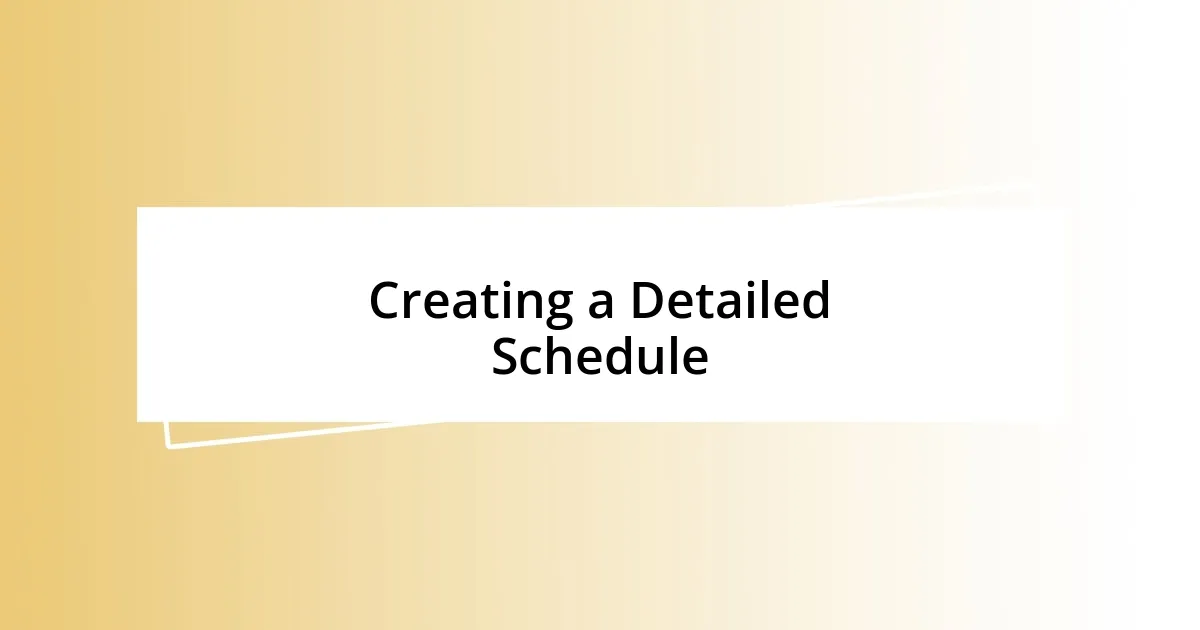
Creating a Detailed Schedule
Creating a detailed schedule is essential for ensuring that every aspect of your speaker engagement runs smoothly. I remember planning a full-day workshop and realized I needed to map out each hour meticulously. By breaking the day into segments—registration, keynotes, breakout sessions, and even networking—I not only kept myself organized but also helped attendees manage their time effectively. Have you ever experienced the chaos of a poorly scheduled event? That’s a situation I strive to avoid at all costs.
When developing a schedule, it’s important to account for flexibility. During one memorable conference, I found that our initial time slots were too tight, pushing everything off course. After adjusting the schedule to create buffer times between sessions, the atmosphere became more relaxed, and conversations flowed more naturally. I think allowing breathing room helps both the speakers and attendees engage more deeply with the content. It’s all about pacing, isn’t it?
Lastly, I prioritize communication in my scheduling process. I have a habit of sharing the detailed agenda with all participants ahead of time, often marvelling at how it creates a sense of anticipation. Everybody knows what to expect, and it fosters an environment of preparation and enthusiasm. How often do you check in with your audience about the schedule? Regular updates can enhance their experience and keep everyone on the same page, which is invaluable for successful engagement.
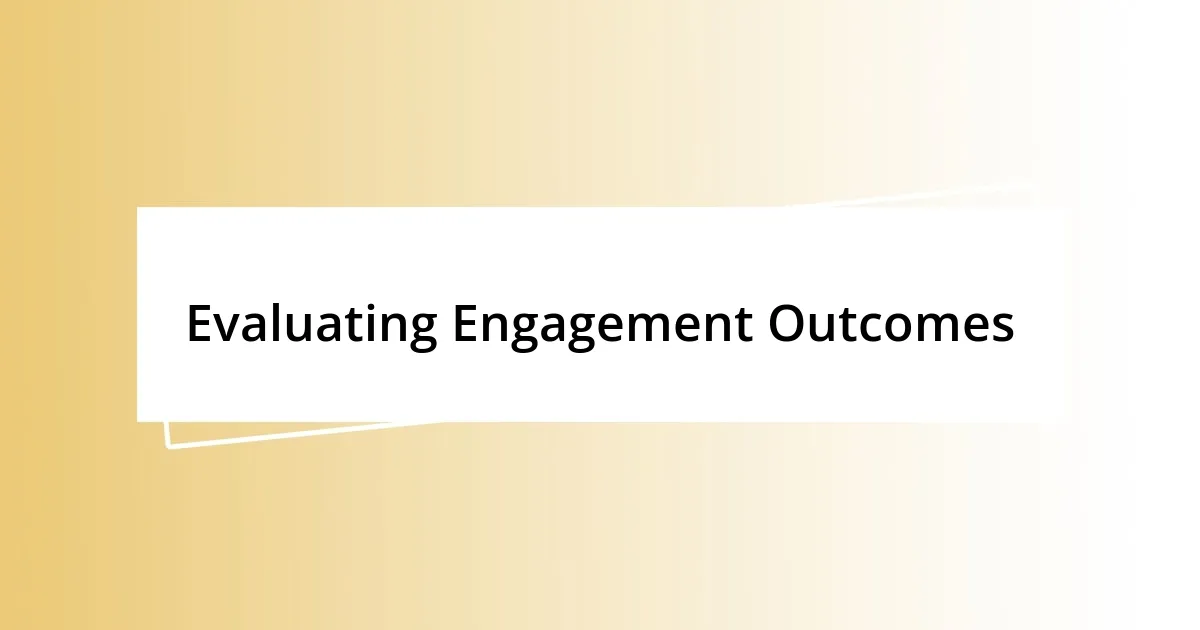
Evaluating Engagement Outcomes
Evaluating engagement outcomes is a critical aspect of my speaker engagement plan. After delivering a session, I always take a moment to reflect on how the audience reacted. Did their faces show interest or confusion? I recall a time when I noticed several attendees nodding along enthusiastically while others appeared lost. That contrast made me realize the importance of gauging overall engagement through both verbal and non-verbal cues. Have you ever considered how those subtle signals can inform your future presentations?
As feedback comes rolling in, I analyze it not just for what went well, but for areas of improvement. I distinctly remember receiving mixed reviews after a panel I moderated; some loved the diverse viewpoints, while others felt it lacked depth. That feedback prompted me to tailor future engagements more thoughtfully. What if I encourage more in-depth discussions next time? Engaging with participants post-event often uncovers invaluable insights that help refine my approach.
I also use metrics to quantify engagement. After one workshop, I collected data on participation rates in breakout discussions versus audience questions during the main presentation. Interestingly, the breakout sessions had a higher level of engagement, which led me to prioritize interactive formats in future events. How do you measure the success of your engagements? For me, combining qualitative and quantitative feedback provides a well-rounded understanding of the effectiveness of my efforts.
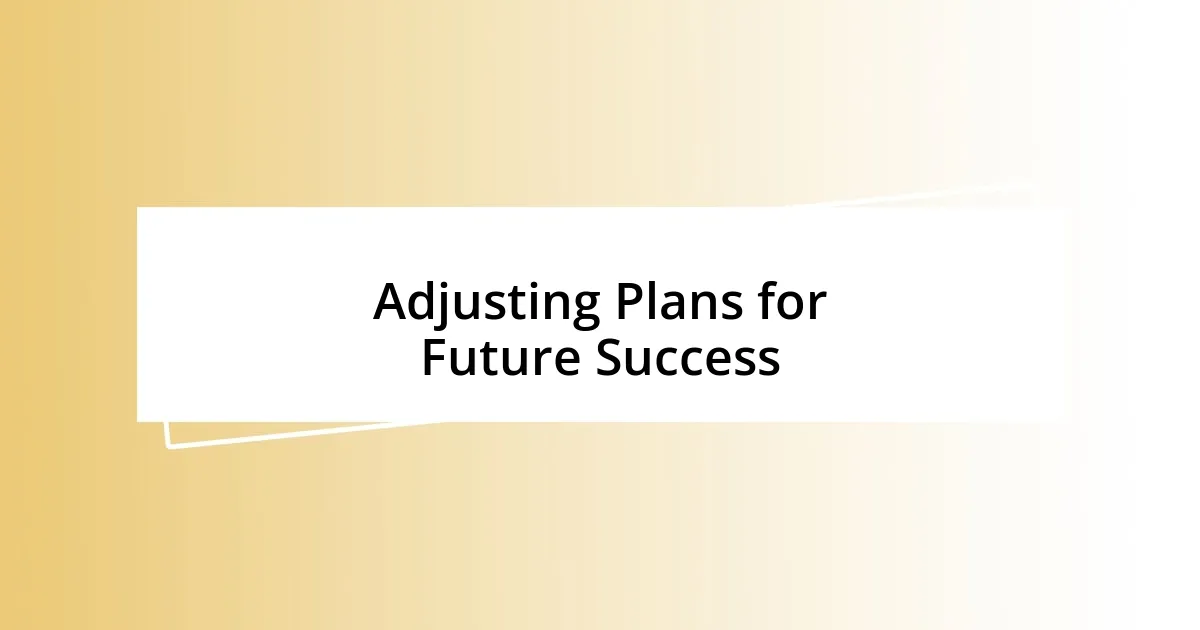
Adjusting Plans for Future Success
Adjusting plans for future success involves an ongoing commitment to learning and growth. I once worked with a speaker who relied heavily on PowerPoint slides. While the visuals were informative, engagement levels plummeted. After the event, I suggested we mix in interactive polls and video snippets for our next session. It was a simple adjustment that transformed the experience, boosting audience interaction and enthusiasm. Have you ever had to pivot mid-plan to better meet your audience’s needs?
I also find that regularly revisiting my engagement strategies keeps them fresh and relevant. After a particularly successful workshop, I thought I had it all figured out. But as I reflected on the event, I realized I had overlooked some participants who needed more hands-on support. By implementing breakout groups in future sessions, I fostered deeper discussions, which left attendees feeling more valued. How often do you evaluate your methods to ensure everyone gets the attention they deserve?
Building on past experiences is invaluable. I remember feeling disheartened after a session where the audience seemed disengaged. A dear colleague reminded me that every setback is a lesson—it shifted my perspective. Now, I actively seek out what went wrong to shape my new plans. It’s about being proactive rather than reactive, creating a cycle of constant improvement. Isn’t it amazing how adjusting our approach can unlock fresh possibilities for connection?












